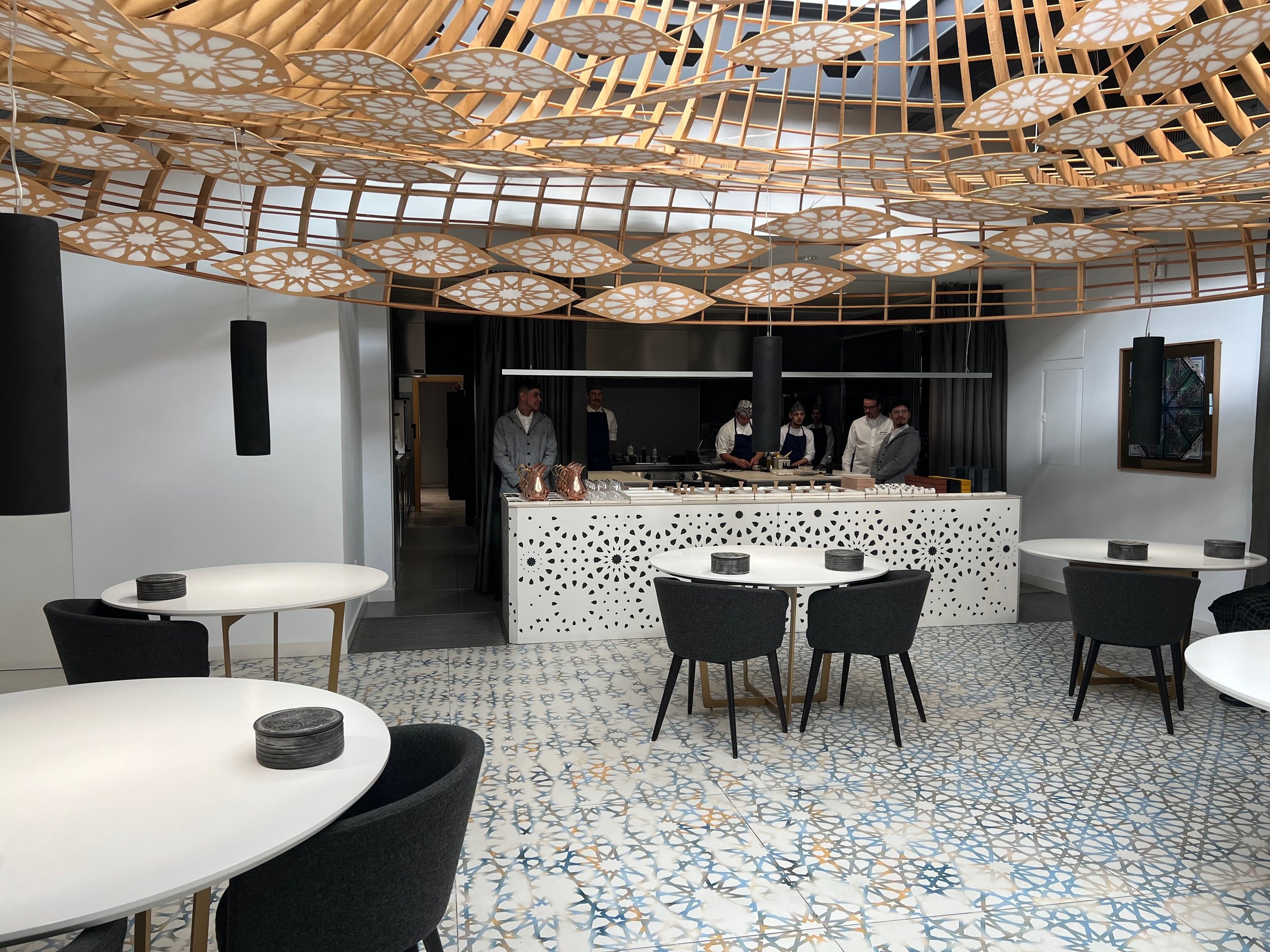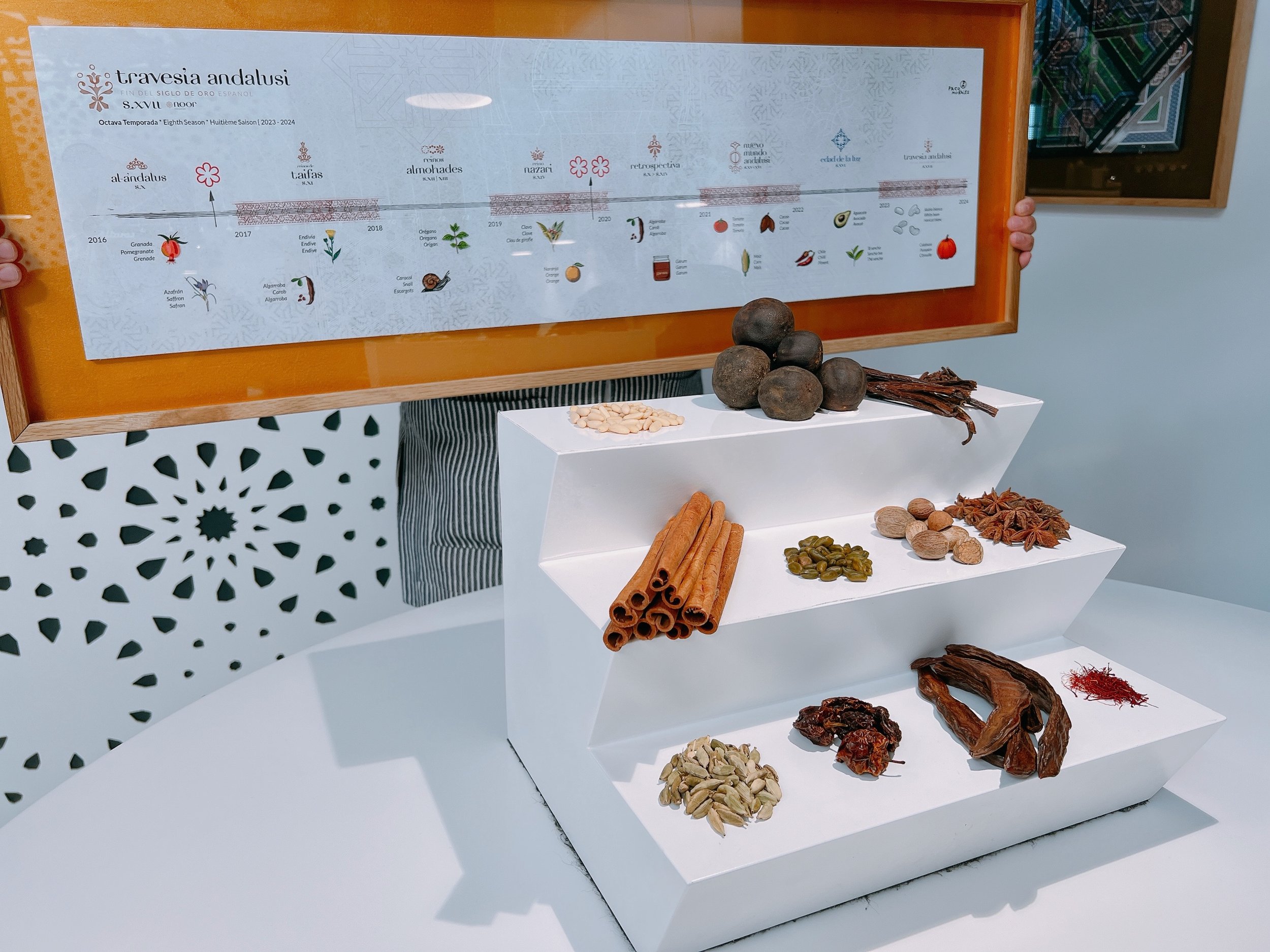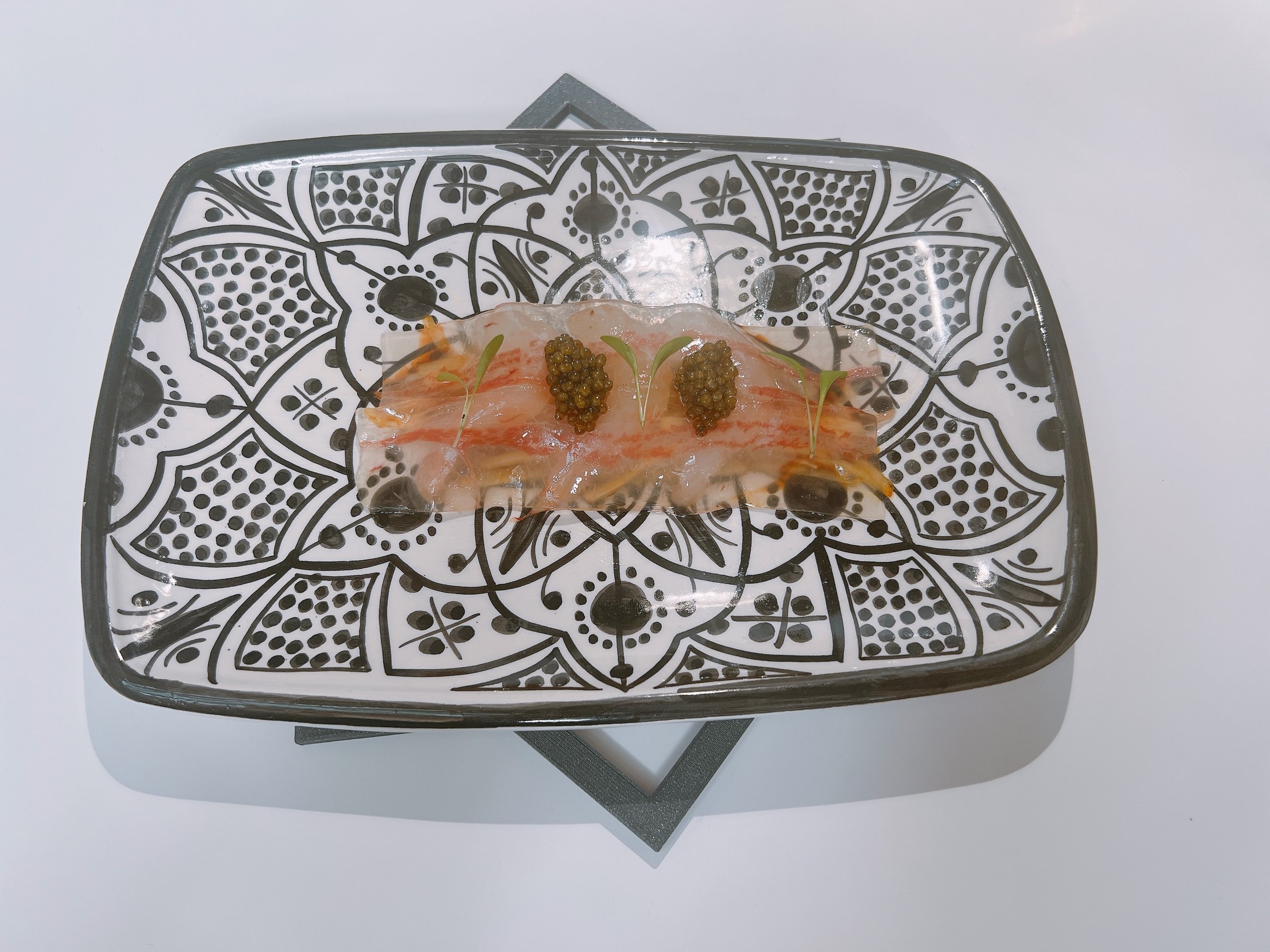Noor - Córdoba
Rating: 15/20
Where: Córdoba, Spain
When: Lunch for 2 on 11 January 2024
Cost per Person: Tasting menu 145-245 Euro, Wine pairing 75-125 Euro
Accolades: 3 Michelin Stars
Why: Modern interpretations of historical Andalusian cuisine
“Noor”, a restaurant in Córdoba, received its third Michelin star in late 2023. It is located in a residential neighborhood, only a short walk from the city center. Its futuristic metallic facade stands out on a orange-tree-lined street full of nondescript apartment buildings. But Noor is unusual even in a culinary sense. Whereas most three-star restaurants in Spain go for a modern, technical style of cooking that is only limited by the chef’s whims, Noor actually has a program and a mission. The name of the restaurant means “sacred light” in Arabic, and its culinary goal is to shine a light on historical Moorish and Andalusian cuisines. (The Moors, Muslims from Northern Africa, conquered and ruled Andalusia in Southern Spain for much of the Middle Ages. Back then, Córdoba was their capital and the largest city in Europe.) To that end, the chef covers a different century of cuisine every year, starting with the 11th century back when the restaurant received its first Michelin star. At the time of our visit, we were in the 17th century.
After entering the restaurant through a sliding door, we were first given the opportunity to wash our hands with warm rose water - apparently an old custom. Then it was on to the dining room whose predominant color was white and had only minimal decorations. Eight tables faced the open kitchen, where the chefs were already hard at work assembling the upcoming amuse bouches. All tables were filled during our lunch visit, and in fact the restaurant was booked solid for three months. That's quite a change from the previous two-star days, when next-week reservations were easily attainable.
Three tasting menus were available, priced at 145, 170 and 245 Euro, with each successive menu simply adding more courses. Corresponding wine pairings were priced at 75, 95 and 125 Euro, respectively. To try the most dishes, we went for the longest menu and its matching wine pairing. These wines came mainly from Spain, except for a Japanese sake and two whites from Lebanon and Germany. They went fine with the food, but were not outstanding. What was remarkable, though, was the age of the wines - some of them were older than 30 years. We even got an excellent dessert wine from my birth year - a happy coincidence. Not something that one usually sees in wine pairings, and the price of the pairing seemed fair for what one received.
Curiously, the wine glasses for the pairing were not removed even after I had emptied them. Only once I mentioned this to the sommelier did my (at this point quite considerable) stemware collection disappear, and subsequent glasses were henceforth removed promptly. I've seen this at one other three-star restaurant in Spain, so maybe it's just considered impolite to remove empty glasses unless asked to? Similar to how one wouldn't receive the check unless it’s requested? Interesting.
After a visual presentation of the spices to be used in the upcoming meal, we started with a trio of amuse bouches. A black bread cracker was topped with chickpeas, mole and an anchovy mayonnaise. It sat across a cup filled with a cucumber mint soup. The cracker was almost too sturdy, and its toppings slightly sweet. Fine, but not too exciting, maybe a 15. Much better was the soup, which was a bit creamy but very light, and full of cucumber flavor - I couldn't detect the mint, however. A 18 or 19 by itself. Overall 17. Next we tried a small fried “bun” topped with tuna and a saffron sauce. Eaten together, the doughy fried bun dominated the taste to the extent that the fish and saffron were lost 15. Finally, a deer tartare was served on a mini zucchini and a rose leaf. Here, the rose was by far the prevailing flavor, relegating tartare and zucchini to texture-only supporting roles. In an ideal world, the ingredients would be a bit more balanced 15.
After finishing the appetizers, we were served a dish of poached quail. Two pieces of deboned quail meat were served on top of a pork black pudding and surrounded by a corn-based sauce and slivers of pickled almonds. The quail was cooked excellently: juicy, tender and flavorful. Even more flavorful was the black pudding - it added a meaty, savory, well-seasoned component to the dish. The corn sauce was a bit acidic, and my dining companion claimed to detect hints of vanilla. I'm not sure whether the almonds were strictly necessary, they merely provided texture, and the dish would probably have been fine without them. Very nice otherwise 17.
Next, a blue lobster came with an emulsion of lobster coral, daikon and cardamom. Each of the two pieces of lobster was topped with citrus fruit meat. The creamy sauce was very lightly flavored, maybe serving it warmer than lukewarm (or adding more salt) would have helped in bringing out more flavor. In addition, the lobster was a bit chewy, making this dish fall somewhat short of expectations 15.
The base of the following dish was a cod mousse. It came with an egg yolk topped with caviar, sliced caperberries, some tiny mushrooms and chili peppers. Texture-wise, the mousse was actually closer to a thick jelly, and sadly barely tasted of fish. Instead, the dominant flavor came from the liquid-inside egg yolk. Some parts of the mousse were a bit spicy due to the chili. The caperberries were only lightly pickled, so didn't add much acidity. This was a pleasant dish, but it seemed to have pulled its punches when it came to flavors. Everything was a little bit mellow, just like the lukewarm serving temperature 16.
The following course was a cooked oyster, conveniently cut into two pieces as well. It was served cold, sitting on top of a spinach gelee, and was accompanied by sweet peas and frozen stars of sheep's milk cream. The oyster was juicy, but its subtle flavor got lost among the other ingredients. Likewise, the peas barely tasted of peas and simply contributed some popping texture. Overall, this dish was distinctively bitter, possibly from the spinach gelee, and the other flavors didn't really come together as a whole. It wasn't entirely clear what the intention behind this course was 14.
At this point, three kinds of bread were offered, all served warm, and all continuously refilled for the rest of the meal: a seeded sliced bread, a puff pastry and an olive oil bread roll. My favorite was the seeded bread which was chewy and had a nice crunchy crust. The puff pastry was, contrary to its looks, neither crunchy nor flaky, but actually quite soft, similar to a brioche. The olive oil bread didn't have much of an olive flavor 15.
A signature dish of the restaurant came next. It was based on pine nuts, apples and ras el hanout, a north-west African spice mix. Pine nut cream formed the dish's base layer, and it was topped with roasted pine nuts, a pine nut ice cream and little apple cubes covered with spices. The ice cream had a touch of sweetness, but the rest of the dish was savory. Flavorwise, it was nutty, creamy and had a hint of fruit. Texture came from the apples and the (soft) roasted pine nuts. Quite nice, in fact. Interestingly, with a bit more sugar, this could easily have passed for a dessert 17.
Lightly poached shrimp were served over sliced endives, seasoned with 50-year-old PX vinegar, and topped with slices of bacon and dollops of caviar. This dish was unfortunately also a bit bitter, this time from the endives that also had a curry-like flavor. The shrimp were nicely cooked and lightly sweet. The bacon tasted great, but had an extremely chewy texture since it was essentially all fat, which made it a bit of a chore to eat 14.
Durum wheat pasta was served with a roasted chicken stock, small cubes of chicken meat and sliced squid. The chicken cubes were close to flavorless, but that was the only issue with this dish. The sauce was delicious: rich, smoky, full of roasted flavor - perfectly seasoned. The squid was very tender, with a texture close to pasta as well 18.
Cured sea bass was served with anchovies, small balls of bottarga, pickled cucumbers and a parsley mayonnaise. The fish was served slightly warm, while the rest of the dish was at room temperature - an unusual combination. The fish's texture was unfortunately a touch chewy, and the bottarga made the dish very fishy and also a bit bitter (which was definitely becoming a recurring theme in this meal). The fish pretty much disappeared among all of these strong flavors that (at least for me) didn't come together very well. Too bad, since the sauce by itself was quite lovely 14.
Very thinly sliced aged beef was served with sweet peppers, labneh (a cheese made from yogurt), a turmeric sauce and roasted buckwheat. We were given tweezers to roll the beef around the sauce, cheese and buckwheat. Combining everything made it obvious that there was quite a lot of beef compared to the other ingredients. The cheese was barely noticeable, there was a hint of the peppers and the sauce was more creamy than flavorful. The buckwheat added a nice crunch, but this was a dish with light flavors overall 15.
Marinated deer was served with white truffles, black mushrooms and pickled yellow beets. The black mushrooms were pretty nice, but the rest of the dish didn't come together for me. The meat was close to flavorless, the pickles very, very acidic, and the sauce, well, it was seasoned with plenty of cardamom which made it feel somewhat Christmassy. Not my favorite course 14.
Oh, what could have been... The next dish starred steamed hake that was served with pumpkins prepared two ways: as a sauce containing vanilla and as lightly pickled strips. The fish itself was cooked perfectly: flaky, juicy, tender and salted just right. By itself, an easy 18. But then there was the sauce: quite sweet with a pronounced vanilla flavor, it would have felt more at home in a dessert - an unfortunate accompaniment to a wonderful fish 15.
Our final savory dish was a pigeon that had gone through an elaborate preparation process - we were shown a series of pictures illustrating the different steps. The dish came with generous dollops of pigeon pâté, three little tomatoes crusted with spices, chili and shaved white truffles. On the side was a piece of persimmon topped with labneh and caviar. The pigeon was quite nice, with a good texture, while being light in flavor and having only a hint of gaminess. The tomatoes were not sweet, but rather savory and acidic. For my taste, there was a bit too much pâté on the plate - its umami flavor dominated the other savory parts of the dish. Altogether a muted dish, flavorwise. Quite the opposite though was the perfectly ripe and very sweet persimmon, which was lovely together with its toppings (17 by itself), and provided a nice bridge to the desserts 15.
Walking to the restaurant, we had been amazed by the fruit-laden orange trees all throughout the city. So it only felt appropriate that our first dessert was based on “neighborhood oranges”. These came in multiple preparations: raw, as a sauce, as a sorbet and as small jelly cubes. The dish was finished with orange blossoms, fried almonds and olive oil. A very nice, fruity dish that wasn't too heavy and had only a hint of bitterness. And I loved the fact that it was very local 17.
Burnt eggplant ice cream?! Clearly, the kitchen is not shying away from a challenge. Said ice cream was paired with white sesame and dates prepared in different textures. Starting with the non-ice-cream parts: they were not bad. The date paste on the side of the dish was tasty, one of two solidified white foams was creamy, while the other added a nice crunch to the dish. The ice cream however... it didn't actually taste of eggplant as far as I could tell, but rather had a strong smoky, charred aftertaste. I commend the kitchen for trying, but this didn’t really work for me in the end 14.
The final dessert ended on a more positive note. A carob tarte had layers of walnuts, white chocolate and fig jelly. These different flavors combined very nicely: chocolaty + caramelly + fruity = yum 16.
Five petit fours ended our almost four-hour-long lunch. A lokum jelly made with honey and roses tasted mostly of rose 14. A saffron/cinnamon bonbon topped with a candied almond was a mixed success: the almond was great, but the bonbon's filling was very heavy 13. The best of the five was a white chocolate lemon bonbon, it had a flavor similar to lemon yogurt 16. Gianduja made from pistachios was flavored with jasmine. The pistachio flavor was strong, with merely a hint of jasmine 13. Lastly, an infusion of roasted peppers and ginger. My first thought upon drinking this was "wtf?!". This was essentially water with a peppery flavor, not sweet at all, and not particularly tasty either 11.
Looking back on our meal, it fell somewhat short of the expectations raised by the three Michelin stars. So what had happened?
Generally, I'm a big fan of themed tasting menus. Even if not all dishes are to one's liking, at least there is an underlying reason of why they are being served the way the are. A good example is Southern Spain's other three-starred restaurant Aponiente, where almost all ingredients are drawn from the ocean. Some dishes ended up being a bit weird (to say the least), but the intellectual accomplishment and determination were consistently impressive.
In Noor's case, lots of work has reportedly gone into researching historical dishes, their ingredients and culinary techniques, so one could have hoped for an experience similar to Aponiente. But what was missing here entirely were the explanations of the “why” for each dish - we didn't get any historical context. Maybe some of this was lost in translation - Spanish-speakers might have received more information -, but given that the three stars will attract a more international clientele, that's little consolation. Without any context, a bitter dish just tastes bitter, a burnt dish just tastes burnt, and Christmassy spices just seem misplaced in a savory dish. Knowing the reasoning behind the flavors wouldn't necessary make me love the food all of a sudden, but at least it would give me a chance to appreciate what the kitchen was trying to accomplish. Without that background, one cannot help but worry that the dishes didn't come out as intended.
Overall: A meal recreating historical Andalusian dishes from the 17th century for a contemporary audience. For me, the result was interesting rather that delicious, with the misses far outnumbering the successes. My main disappointment was the lack of explanations of the thinking behind the dishes, in particular regarding their historical context. What could have been an educational experience became more of a guessing game as to whether the dishes were really meant to come out the way they were. Hopefully, that will be a relatively straightforward issue to fix 15.






















